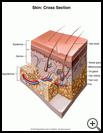
Skin Infection: Cellulitis
What is cellulitis?
Cellulitis is an infection of the skin and tissue under it. This infection is serious and needs to be treated right away. Without treatment the infection can damage skin tissues. It could spread quickly through the bloodstream to other parts of the body and become life threatening.
Cellulitis can be easier to get or more severe if your child has a medical condition, like diabetes or HIV/AIDS, that makes it hard for the body to fight infection.
What is the cause?
The infection can be caused by different types of bacteria. Bacteria get into the body through a cut or sore. The infection spreads over the area within a day or two and can affect tissues below the skin.
A particularly dangerous type of cellulitis called orbital or periorbital cellulitis can affect the eyes. Swelling of infected tissue around the eye can trap and damage nerves and permanently affect vision.
What are the symptoms?
Cellulitis most often occurs on the face, arms, or legs, but it can happen anywhere. Symptoms of cellulitis may include:
- redness
- swelling
- extreme tenderness or pain
- skin that feels hot to the touch
- red streaks from the wound or sore
- pus-filled sores
- swollen and tender lymph glands
- fever
How is it diagnosed?
Your healthcare provider will ask about your child’s symptoms and examine your child. Your child may have tests of blood and discharge from sores. Your healthcare provider may get a sample of pus or use a small needle to obtain a sample of infected skin for lab tests to see what type of bacteria are causing the infection. If a severe infection is suspected, your child may have blood tests or X-rays.
How is it treated?
The infection is treated with an antibiotic. If your child is treated with an antibiotic taken by mouth, your provider will probably want to see your child or talk to you 1 or 2 days after your first visit to make sure the antibiotic is working. If the infection does not get better with oral antibiotics, your child may need to be treated at the hospital with IV antibiotics.
If the infection is more severe, your child may need to stay in the hospital to receive intravenous (IV) antibiotics and to be observed to make sure your child is getting better with treatment.
If your child has a sinus infection that is causing orbital cellulitis, your child may need surgery to drain the infection from the eye socket and sinuses.
How long will the effects of cellulitis last?
If treated right away with antibiotics, the infection usually clears up within 1 or 2 weeks.
A skin infection that is not promptly or properly treated may lead to:
- infection in the blood
- gangrene (areas of body tissue destroyed) and possible loss of a body part (amputation)
- meningitis if the infection spreads to the brain
- death
Orbital cellulitis can also cause a loss of vision.
How can I take care of myself?
- If your child is taking an antibiotic, make sure your child takes all of it exactly as prescribed.
- Ask your child’s healthcare provider how to care for the infected area. For example, your provider may recommend that you:
- Put a warm, moist towel or heating pad on the reddened area 3 times a day for 20 minutes at a time.
- Elevate the area as much as possible on pillows above the level of the heart to decrease swelling and pain.
- Give your child pain medicine, such as ibuprofen, as directed by your provider. Nonsteroidal anti-inflammatory medicines (NSAIDs), such as ibuprofen, may cause stomach bleeding and other problems. These risks increase with age. Read the label and take as directed. Unless recommended by your healthcare provider, your child should not take the medicine for more than 10 days. Check with your healthcare provider before you give any medicine that contains aspirin or salicylates to a child or teen. This includes medicines like baby aspirin, some cold medicines, and Pepto-Bismol. Children and teens who take aspirin are at risk for a serious illness called Reye's syndrome.
Ask your healthcare provider:
- how and when you will hear your child’s test results
- how long it will take to recover from this illness
- what activities your child should avoid and when your child can return to normal activities
- what symptoms or problems you should watch for and what to do if your child has them
Make sure you know when your child should come back for a checkup.
How can I help prevent cellulitis?
- Clean cuts, scrapes, and other skin injuries well with soap and water.
- Keep wounds and sores clean and covered with a bandage. Change the bandage daily, or sooner if it gets dirty or wet.
- See your child’s healthcare provider for treatment as soon as possible if a wound or sore shows signs of infection.
- If your child has diabetes, follow your provider’s instructions for good skin care and keep your child’s blood sugar under good control.
Last modified: 2012-02-09
Last reviewed: 2012-01-04

